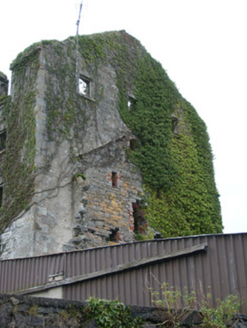Survey Data
Reg No
40909916
Rating
Regional
Categories of Special Interest
Architectural, Historical
Previous Name
Coxtown Mills
Original Use
Mill (water)
Date
1790 - 1830
Coordinates
192465, 371843
Date Recorded
13/11/2007
Date Updated
--/--/--
Description
Detached eight-bay five-storey over basement former corn and/or flour mill, built c. 1810, now ruinous and out of use. Roof now collapsed, formerly pitched natural slate. Projecting cut stone eaves course. Squared and coursed rubble stone walls with dressed flush ashlar block-and-start quoins to the corners. Walls now largely overgrown with vegetation. Square-headed window openings having cut stone voussoirs over, timber lintels and cut sandstone sills. Some cast-iron lattice window frames and fittings remains. Square-headed door openings with cut stone voussoirs, timber lintels and battened timber doors or remains of battened timber doors. Set back from road in own grounds to the north of Ballintra. Located on the north bank of the Ballintra River. Ruinous outbuildings to west and to site; evidence of former block, now demolished, attached to the west gable end having pitched slate roof. Modern two-storey flat-roofed outbuilding attached to the north-west corner. Section of rubble stone boundary wall to the north having integral segmental-headed carriage-arch with red brick voussoirs. Remains of other rubble stone boundary walls to site. Former millrace, now dry, runs from the east to west to the east of mill.
Appraisal
This large-scale and imposing former flour mill complex is one of the most significant elements of the industrial heritage of south County Donegal. Although now derelict with roof collapsing and floors removed, this building retains its early form and stark industrial character. It is well-built using good quality squared rubble stone masonry with fine quoins to the corners, and its continued survival despite a century of disuse is testament to the quality of the original construction. This is one of the few purpose-built merchant flour mills in this part of County Donegal, the majority of other mills were built to mill corn and oats for local use. Flour mills are usually on a much larger scale due to the need to have vast storage areas for meal, corn and flour, which is the case here at Urbalshinney. It probably originally dates to the very end of the eighteenth century or the first decades of the nineteenth century, which was a boom period for the Irish corn/oat milling industry. There is evidence for a large later three-storey block that was attached to the west gable end, now demolished. It appears to have gone out of use during the last decades of the nineteenth century (possibly being replaced by the corn mill to the east –see 40909915), and is depicted as roofless on the 1907 Ordnance Survey twenty-five inch map of the area. This mill may have been originally built at the expense of the Hamilton family, the local landlords at the time of construction, of nearby Coxtown Manor (see 40909913) who built and ran mills somewhere around this area c. 1840 (record of Hamilton, Alexander and Andrew, Millers, Coxtown Mills, in 1846). The scale of this building indicates that very significant resources were employed in its original construction. Griffith’s Valuation of 1857 records that a William Armstrong was the miller here at this time, when the holding was described as consisting of a ‘house and land, flour mill, house, office and yard’ with a rateable value of £98 and 10s, and a ‘house, corn mill and kiln’ with a rateable value of £38 and 15s. This imposing industrial building is of considerable social and economic significance to the local community, and would have employed a considerable work force in its heyday. In addition to representing the transition from the vernacular milling tradition to industrial mechanisation, this building stands as a symbol of the physical impact of large-scale industry on the rural landscape. This ruinous building dominates the landscape to the north of Ballintra, and is an integral element of the built heritage of the local area. It forms part of a group of related structures along with the remains of the later former corn mill to the east (see 40909915) and the probable former mill manager’s house adjacent to the west (see 40909918).













